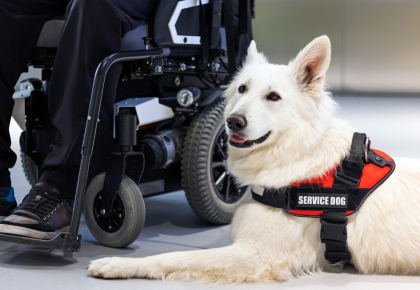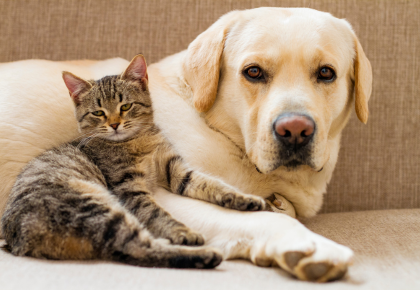 Most community associations aren’t just made up of human residents. You can often find a variety of four-legged residents as well! Furry friends are often a welcome addition, as they can liven up a community and improve the mental health of residents. However, they can also lead to disagreements, messes, property damage and in rare cases, injury.
Most community associations aren’t just made up of human residents. You can often find a variety of four-legged residents as well! Furry friends are often a welcome addition, as they can liven up a community and improve the mental health of residents. However, they can also lead to disagreements, messes, property damage and in rare cases, injury.
Figuring out how to make sure your human and pet residents can all live together in harmony is a challenge many community association boards face.
The easiest solution is to have solid community association pet rules. However, they need to be sensible and easy to follow. In this article we’ll breakdown what your community association board needs to consider when creating reasonable pet rules for the community.
Understand the difference between a pet and a service animal
 Ahead of making rules around pets, it’s important to understand the difference between a pet and a service animal. For the purposes of creating rules for your community, pets are defined as companion animals. Pets can provide emotional benefits to their owners, such as reducing stress or easing loneliness.
Ahead of making rules around pets, it’s important to understand the difference between a pet and a service animal. For the purposes of creating rules for your community, pets are defined as companion animals. Pets can provide emotional benefits to their owners, such as reducing stress or easing loneliness.
Service animals are working animals that assist people with disabilities and are not considered pets. In Illinois, the Service Animal Access Act and White Cane Law guarantee the rights of a person with a disability to be accompanied by a service animal in public. This includes the use of a service animal in places that they are typically prohibited.
Draft reasonable community association pet rules
According to a recent Forbes article, 66% of U.S. households own a pet and 85% of dog owners and 76% of cat owners consider their pets to be a member of the family. With that in mind, you can be almost certain you’ve got furry friends living in your community. Having solid rules in place will help pets and their owners remain good neighbors and not a nuisance.
As tempting as an outright ban on pets can be to eliminate any issues, a community being pet-friendly can be an important selling point for many potential residents. That’s why solid pet rules can go a long way to keep pet issues to a minimum.
When creating the rules, you need to remember that each one should have a purpose that is easy to define and easy for residents to follow. To make sure you’re on the right track, discuss the potential rules with your legal counsel. They will be well versed in local and state laws you may need to consider. For example, in many places a service animal means a dog, in Illinois, a service animal can be a dog or miniature horse.
Community association boards typically make rules around the following:
-
The number of pets permitted
-
Weight, size, or breed of animals
-
Areas where residents can keep or take pets
-
Requirements for where on the premises pets must be leashed
When considering these kinds of rules, it’s important to consider rules that can be fairly and reasonably enforced. For example, many associations want to put weight limits on animals to keep larger animals out of the community. However, rules specific to an animal’s weight can be hard to enforce. Who is responsible for weighing all the pets to ensure the rule is being followed? What happens when a dog gains a few pounds from too many treats and ends up over the weight limit?
As you can see, setting weight limits is not the best way to go about keeping large animal breeds from moving in. If your board wants a rule about the specific types of animals and breeds that are allowed in the community, it’s easier to list what breeds and types of animals are and are not allowed. If you choose to set a rule about specific breeds, you should work closely with your attorney to craft it, making sure you aren’t setting something unrealistic.
An example of a rule that every community could put in place would be to state that an animal’s owner must clean any waste deposited in common areas, and refusal to do so would result in a fine. To make this rule easier for residents to follow, you could consider placing dog waste disposal units that include a bag dispenser in the common outdoor areas that pets are allowed to use.
Not only does a rule like this show that your board is dedicated to keeping association grounds clean, but the addition of a pet amenity goes a long way in showing you consider pets a valuable part of your community.
To make sure your rules are written in such a way that they aren’t open to interpretation, have your legal counsel review them.
Communication and compliance
Once you have drafted or updated your community’s pet rules, the next step is communicating them and ensuring residents comply.
 It’s important to communicate the rules to all residents, either to bring them up to speed or as reinforcement, so that all community members are compliant with the policies. The rules should be communicated clearly and frequently to all residents, using as many communication channels as possible, including email, newsletters and flyers posted throughout the community.
It’s important to communicate the rules to all residents, either to bring them up to speed or as reinforcement, so that all community members are compliant with the policies. The rules should be communicated clearly and frequently to all residents, using as many communication channels as possible, including email, newsletters and flyers posted throughout the community.
It's important to note that if your community has units that are rented out by the owner, they can have their own additional pet rules. For that reason, within your communication it’s important to point out for tenants that the rules set by their landlord may differ than those set by the board. And they are required to follow their landlord’s rules.
Consistency and fairness in enforcing the rules will go a long way toward making sure all residents comply with them. When it comes to how complaint procedures are handled, you should work with your association’s attorney.
Lean on your legal counsel and community association management team
Like with the creation of any rules for your community association, there is a lot to consider when it comes to pet policies. However, because this is about resident’s furry family members, it’s often more complex and can be a sensitive issue for community members. That’s why it’s so important to work closely with your legal counsel when drafting the rules. They will help you create sensible rules that can be enforced, setting your community up for success.
And when it comes to communicating and enforcing the rules, it’s important you lean on the expertise of your community association management team. They have the experience and tools to make communicating and enforcing the rules a breeze. Because reasonable pet policies can go a long way in keeping your human and four-legged residents happy.